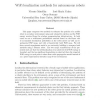Free Online Productivity Tools
i2Speak
i2Symbol
i2OCR
iTex2Img
iWeb2Print
iWeb2Shot
i2Type
iPdf2Split
iPdf2Merge
i2Bopomofo
i2Arabic
i2Style
i2Image
i2PDF
iLatex2Rtf
Sci2ools
ROBOTICA
2006
2006
WiFi localization methods for autonomous robots
This paper compares two methods to estimate the position of a mobile robot in an indoor environment using only odometric calculus and the WiFi energy received from the wireless communication infrastructure. In both cases we use a well-known probabilistic method based on the Bayes rule to accumulate localization probability as the robot moves on with an experimental WiFi map, and with a theoretically built WiFi map. We will show several experiments made in our university building to compare both methods using a Pioneer robot. The two major contributions of the presented work are that the self-localization error achieved with WiFi energy is bounded, and that no significant degradation is observed when the expected WiFi energy at each point is taken from radio propagation model instead of an a priori experimental intensity map of the environment.
Related Content
| Added | 15 Dec 2010 |
| Updated | 15 Dec 2010 |
| Type | Journal |
| Year | 2006 |
| Where | ROBOTICA |
| Authors | Vicente Matellán Olivera, José María Cañas Plaza, Oscar Serrano Serrano |
Comments (0)

